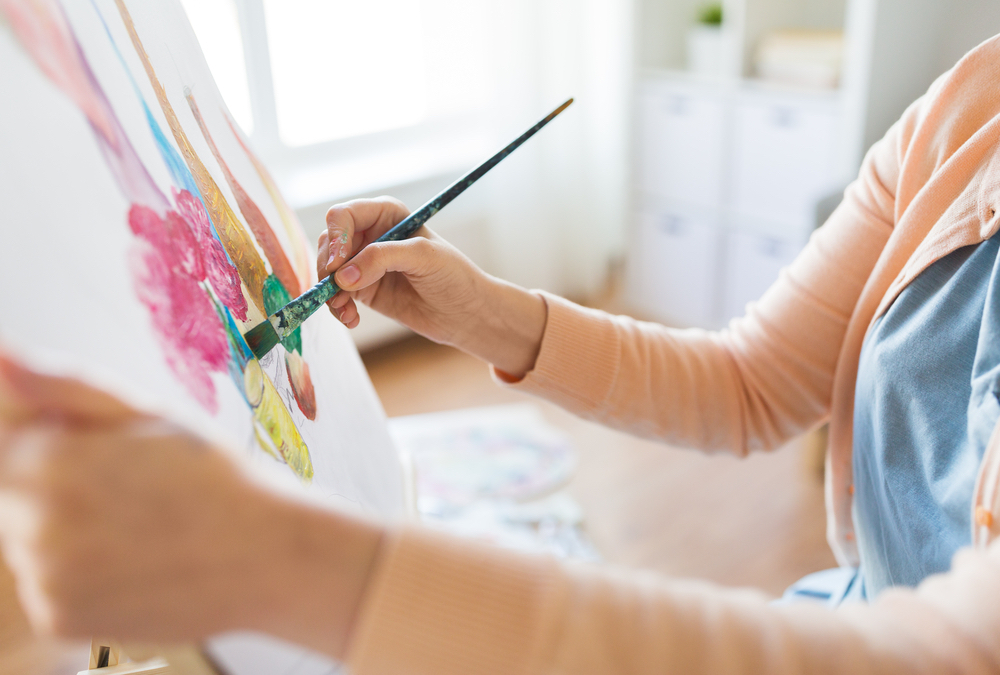In the most basic terms, art therapy is the use of a creative medium (such as painting, drawing, sculpting, journaling, dancing, scrapbooking, etc.) within a mental health context. This activity is known to promote relaxation, enjoyment, healing, self-expression, and a host of other wellness benefits. People of all ages and walks of life can participate in art therapy—there’s no skill level required. If you’re unable or not sure how to verbally process complex feelings, art therapy can provide an immersive, hands-on outlet to safely unlock those emotions.
Whether it’s used as a standalone practice or in conjunction with other therapeutic methods, this technique can help boost your mental and emotional wellbeing in numerous ways. From a tool for stress management to intervention for anxiety, depression, cognitive decline, or trauma recovery, its benefits run the gamut. The International Journal of Environmental Research and Public Health found that creative pursuits lead to more happiness and satisfaction overall. Here are four specific areas in which art therapy can enhance your life.
Art Therapy Bolsters Cognitive Function
Since creating artwork is both sensory and experiential, it activates and strengthens many important cognitive functions. Art is a window to the imagination, but it also helps fine-tune motor skills, verbal fluency and concentration. This is particularly beneficial for those with dementia, who often lose their dexterity and speech as the condition progresses, the memory care experts at Vineyard Senior Living point out. Even as they suffer a cognitive decline in other areas, art therapy provides an accessible outlet for dementia patients to communicate their thoughts and stimulate parts of the brain they still have control of.
Art Therapy is a Positive Outlet for Stress
It feels so calming to swirl a paintbrush across a canvas and watch a vibrant scene take shape. That’s because a creative outlet takes your mind off the urge to be productive, so you can relax and focus on what you’re doing in the moment, rather than worrying about stressors in the future. Art can even be a form of meditation—the texture of clay, the smell of acrylics, the visual stimuli of colors and shapes – all of these elements can help ground you in the present. For this reason, art therapy is an effective stress or anxiety management tool. Next time you feel under pressure, allow yourself a breather to do something creative.
Art Therapy Helps to Regulate Emotions.
Just as the mindfulness aspect of creativity can help relieve stress, it’s also a constructive way to explore and regulate emotions. The PLOS One Journal reveals that art therapy can balance your mood state by serving as a processing outlet. If it becomes too painful or overwhelming to put difficult feelings into words, art therapy can empower you to channel those emotions through a non-verbal medium. As such, you’re still externalizing the emotions instead of repressing them, but you also don’t have to articulate them out loud. This is especially useful for those with post-traumatic stress who often dissociate from their emotions.
Art Therapy Delivers a Self-Esteem Boost.
There’s an inherent sense of achievement that comes from devoting your time and effort to a beautiful, unique, original piece of artwork. When using that unique imagination of yours to turn a blank medium into a creation you’re proud of, this final product can do absolute wonders for your self-esteem. Even if you would not consider yourself the most talented artist, it’s still a confidence boost to see a project through to completion and know that it reflects your best work. If you struggle with self-esteem, art therapy is an excellent form of intervention to help you overcome this obstacle. After all, who doesn’t want to feel more accomplished?
Art Therapy is Beneficial and Valuable for Multiple Areas of Life.
If you haven’t tried art therapy, now is the time to make this healing, restorative practice an integral part of your self-care routine. No matter your age, experience, skill level or therapeutic needs, this activity is both an accessible and effective way to enhance mental and emotional wellbeing. So try to unleash those creative juices and harness the benefits of art therapy for yourself—it’s will bring relaxation, calm, balance and joy to all areas of your life.
The Editorial Team at Lake Oconee Health is made up of skilled health and wellness writers and experts, led by Daniel Casciato who has over 25 years of experience in healthcare writing. Since 1998, we have produced compelling and informative content for numerous publications, establishing ourselves as a trusted resource for health and wellness information. We aim to provide our readers with valuable insights and guidance to help them lead healthier and happier lives.
































